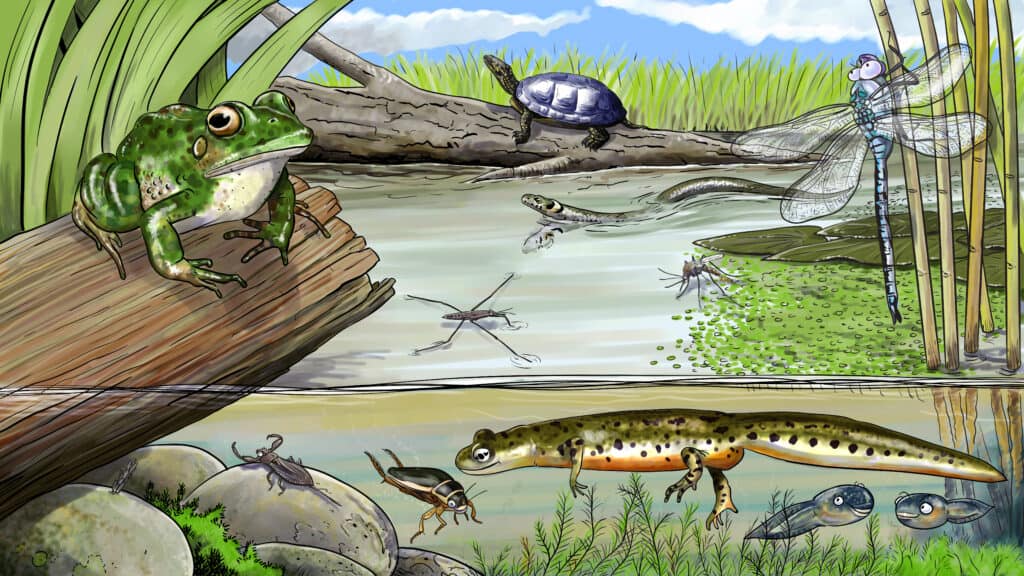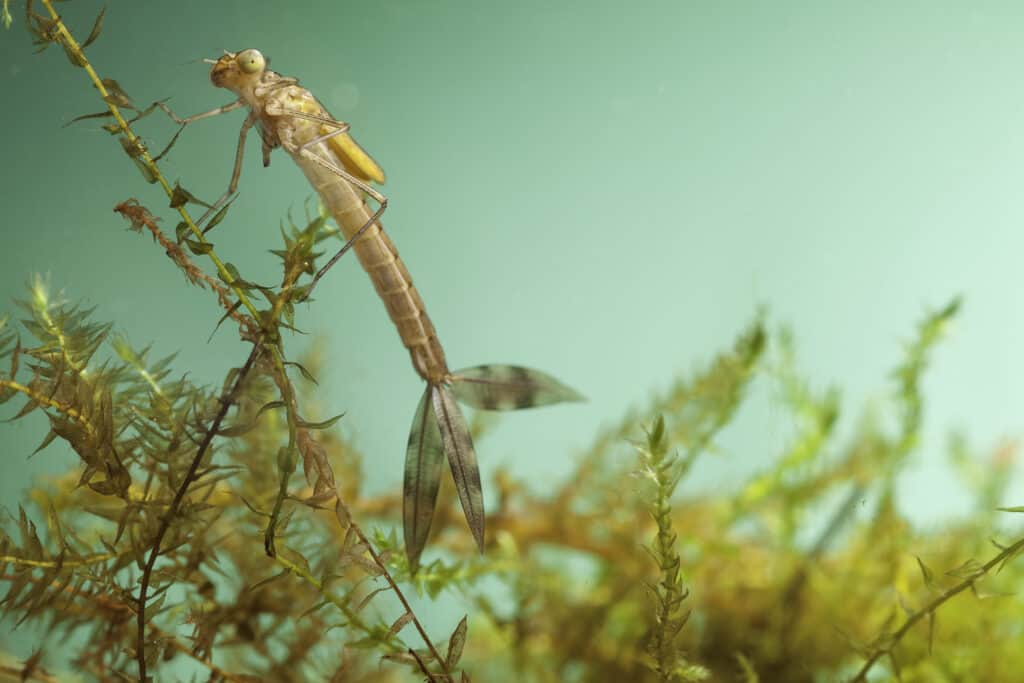
Your garden pond is full of life. This is not only due to the plants and fish in your pond. Especially in the warm season, the pond attracts many animals and is a beautiful biotope. Observe your garden pond in the summer or remove the algae. You may have noticed various animals that you did not put. Your artificially created pond has developed into a species-rich ecosystem. This article will show you which animals could use your pond as a habitat.
One Eats the Other
Eat and be eaten – that’s life in nature. It looks no different in your garden pond. The fish eat mosquito larvae, tiny crustaceans, and small insects, while other animals eat the fish and spawn. The fact that one animal eats the other is entirely harmless in your garden pond as an ecosystem and is even essential for the biological balance. If you put fish in your pond, the natural balance will be upset. However, it will restore itself over time if your fish do not reproduce excessively. Tiny creatures that colonize your pond can be an essential food source for your fish. They can help you save on fish food. Fish provide food competition for frogs and newts. For gray herons, grass snakes, and cats, fish can be an enrichment on the menu.
The Full Life in the Garden Pond
Your garden pond is full of life even if you do not use any fish at all. Various animals regard the garden pond and its surroundings as a welcome habitat and settle down.
You can recognize vertebrates by the shape of their bodies and the number of limbs. Amphibians may spend time in your pond as early as the larval stage when the parent animals spawn there. Among amphibians, a distinction is made between frogs and caudate. Frogs include frogs and toads, while caudate include newts and salamanders. Salamanders, however, are a rarity in Germany.
Frogs and caudates do not have feet at the beginning as larvae. Only during the larval stage do pairs of legs develop. The larvae of frog amphibians are called tadpoles. They have a rudder tail that falls off at the end of the larval stage. Snakes may also be found in the garden pond from time to time. Fish, frogs, newts, and their larvae are on their menu. The grass snake is not poisonous and utterly harmless to humans. It is easily recognized by its two yellow crescent-shaped spots on the back of its head.
The European pond turtle is a reptile and belongs to the endangered animals. Since it is extremely rare, it is unlikely to be a guest at your garden pond. Expected guests at your garden pond are insects. They can be recognized by their six legs and live mostly on land. However, some of them have adapted to live in water in the course of evolution. They live in the water, at least in the larval stage. Insects also include beetles. Some of them prefer water as a habitat, for example, the yellow fire beetle or the piston water beetle.
Larvae of Insects as Important Aquatic Inhabitants
The larvae of insects that reside in your garden pond differ based on their external appearance. In the course of evolution, they have developed different forms of adaptation. You can distinguish these insect larvae from one another based on various characteristics. While the different orders of insects can usually be easily distinguished in the larval stage, the individual species can often only be distinguished by experts. As a pond owner, you do not necessarily need to determine the different species. Insect larvae, especially mosquito larvae, are popular food for many fish and amphibians.
Larvae of the Bipeds
There are more than 1,500 species of two-winged insects whose larvae live in water. The best-known species are the mosquitoes and the flies, of which there are again numerous subspecies. It would go too far to list all these species and their distinguishing characteristics. The mosquito is a typical representative. Only the females bite, as they need the blood to produce their eggs. To develop, the larvae of the mosquito depend on water. They can manage with even small amounts of water. Even a permanent puddle on a flat roof or the water in a rain barrel is sufficient for the mosquitoes.

Mostly the larvae of the mosquitoes hang vertically on the water surface. They take in air with their abdomen. With their front abdomen, they filter the water in search of food.
If you want to stop the pesky mosquitoes and their development, you should pay attention to fish species for which mosquito larvae are desirable prey. Good mosquito larvae eaters are:
- Roach
- Rudd
- Tailor Carp
- Golden orfe
- Goldfish
- Minnow
However, it would help if you were sparing with the fish food. Otherwise, the fish will no longer be hungry for the larvae.
Mayfly Larvae
Adult mayflies live only a few hours or days. Their life is dedicated solely to reproduction. They cannot even eat food, as they are only devoted to producing offspring. However, depending on the species, the larvae can survive in the water for up to three years until they mature into a finished insect (imago) and devote themselves to reproduction again. Larvae look very similar to adult insects. They can usually be identified by their three tail filaments located on their abdomen. There are traditionally fan gills on the stomach, which the larvae use to breathe. Mayflies are not related to true flies, which are bipeds. Decay products of plants and dead tissue of other animals (detritus) and algae are the main food of mayfly larvae. So the larvae are helpful in your algae control.
Larvae of the Reticulated Mayflies
Representatives of the reticulated mayflies are the mud flies. There are tracheal gills on the abdomen of the larvae. They are long, jointed, and hairy appendages. The larvae stay in the mud and feed on other tiny organisms. The larvae usually crawl around on the bottom of the water. To swim, they curve their abdomen, which they do pretty well.
Caddisfly Larvae
Caddisfly larvae are easily recognizable by their caddis. The caddis consists of plant debris, small snail shells, and small stones and protects them from predators. The larvae always carry this caddis, which they have built themselves, around with them. A secretion thread spun by the larvae holds this structure together. Caddisfly larvae often live in stagnant waters, which include garden ponds. The leading food of these larvae is detritus and algae. Thus, the larvae are a helpful aid in algae control.
Dragonfly Larvae
Dragonflies are not only pretty and elegant to look at. They are real flight artists and like to feed on mosquito larvae. Unfortunately, the number of dragonflies has declined sharply in recent years. Voracious predators are not only the adult dragonflies but also their larvae. They often spend several years in the water before the larvae molt into an adult dragonfly.
Among dragonfly larvae, a distinction is made between large dragonfly larvae and tiny dragonfly larvae. Large dragonfly larvae are correspondingly large and have a strong, stocky body shape. There are five short spines on their abdomen, but they do not sting. Damselfly larvae are only tiny and have three-gill leaflets on their stomach for breathing underwater.
Other Animals in the Garden Pond
There may also be snails and mussels in your garden pond. You will need mussels if you keep bitterlings. The bitterlings need painter clams to lay their eggs in the gills of the clams. Snails such as pointed horn snails, swamp cap snails, and post horn snails may also live underwater. The snails are good algae eaters.
Observing Animals in the Water
Various animals such as fish, amphibians, or snails are easy to observe and recognize. The situation is different with insect larvae. If you want to determine the larvae, you should get the following to dine.
- a water container
- a kitchen sieve
- several beaker loupes
- brush
You can use a paintbrush to move the larvae from the mud into a kitchen strainer and a beaker loupe for closer examination. To avoid hurting the larvae, do not touch them with your hands.
Conclusion
The garden pond is a biotope for many species of animals. Fish, newts, frogs, snails, and various insect larvae can live there. Such animals settle themselves over time. Your pond becomes an ecosystem. Multiple animals are helpful for the pond, as they can help you control algae. Various insect larvae provide an essential food base for other animals. Mosquito larvae are a nuisance, but various fish species readily eat them.